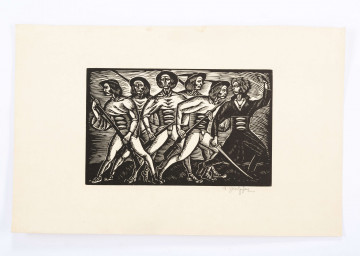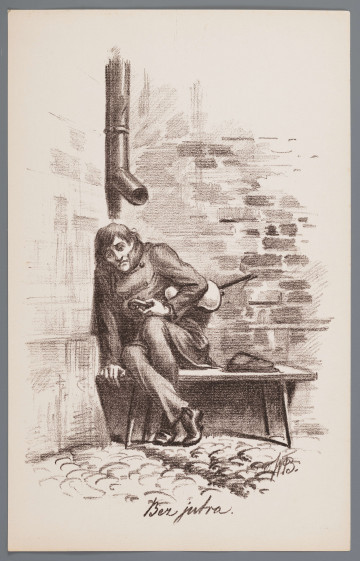
Highlanders
1920s century
National Museum in Lublin
Part of the collection: Polish symbolic painting from the beginning of the 20th c.
Jan Rembowski's biography was marked by illness, which determined his life choices. Unable to continue his career as a sculptor, he pursued his artistic vocation in other fields of art. He was a versatile artist – he successfully occupied himself with painting, drawing, graphic art, illustration, and design and wrote theoretical treatises and poetry. For years, he lived in Zakopane, which influenced the shape of his work, both in terms of content and form.
Rembowski's artistic attitude was shaped by Modernism. His interest in the spiritual side and his depiction of experiences, mental and emotional states through various artistic means were close to his nature.
In 1905 Rembowski, together with L. Gottlieb, V. Hofman, M. Jakimowicz, and W. Wojtkiewicz, formed the Grupa Pięciu [Group of Five] under the motto of renewing the idea of the affinity of arts combining visual, literary and musical elements in a painting with a complex narrative and symbolism. The young artists called for an increase in the significance of the content of a work of art. The opinion-forming circle of the 'Art' Society of Polish Artists was downplayed in favour of decorative form. According to them, the works of J. Malczewski, S. Wyspiański and C. K. Norwid contained a perfect combination of painting and literary elements. The actual patron of the group was the ideologist of Young Poland – S. Przybyszewski.
The use of symbols was an inherent element of the Young Poland style. It was also Rembowski's favourite way of expression. Scena Symboliczna [Symbolic Scene] from 1909, depicting a duel between a man and a monster, is a painting example of this style. The artist drew on the mythological story of the fight between Heracles and the Hydra. In the painting, a naked strongman, facing the viewer, aims his sword at a huge serpentine creature with a head in which glowing eyes glow and an open mouth filled with giant, sharp fangs. The synthetic shot has been limited to the essential elements, which gives it a universal quality. The depicted scene conceals many possible interpretations referring to human fate, in which the eternal struggle with adversities and monsters of one's own imagination is inscribed. The artist was passionate about the subject, and it returned in his works several times.
Bożena Kasperowicz
Author / creator
Dimensions
cały obiekt: height: 71 cm, width: 55 cm
Object type
painting
Technique
oil technique
Material
oil-based paint, canvas, cardboard
Creation time / dating
Creation / finding place
Owner
The National Museum in Lublin
Identification number
Location / status

1920s century
National Museum in Lublin

1913
National Museum in Lublin

1913
National Museum in Lublin
DISCOVER this TOPIC
Castle Museum in Łańcut
DISCOVER this PATH
Educational path